Meat slicing is an art and science, enhancing culinary experiences through precision and technique. Proper slicing ensures tenderness, flavor, and visual appeal, making it a cornerstone of food preparation.

1.1 Importance of Proper Slicing Techniques
Proper slicing techniques are crucial for achieving tender, flavorful, and visually appealing meat. They ensure even cooking, reduce waste, and enhance the overall dining experience. Slicing against the grain prevents chewiness, while freezing slightly firms meat for thin cuts. Consistent slices guarantee uniform cooking, making meals more enjoyable. Mastering these methods elevates both home cooking and professional dishes, showcasing the importance of precision in meat preparation.
1.2 Overview of Popular Meat Slicing Methods
Popular meat slicing methods include thin slicing for stir-fries, uniform cuts for sandwiches, and precise julienne strips for gourmet dishes. Freezing meat before slicing ensures even, thin cuts, while sashimi-grade slicing requires exceptional skill for raw dishes. Additionally, machine slicing offers efficiency for bulk needs, and hand-cut techniques provide artisanal quality. Each method caters to specific culinary demands, enhancing both texture and presentation.
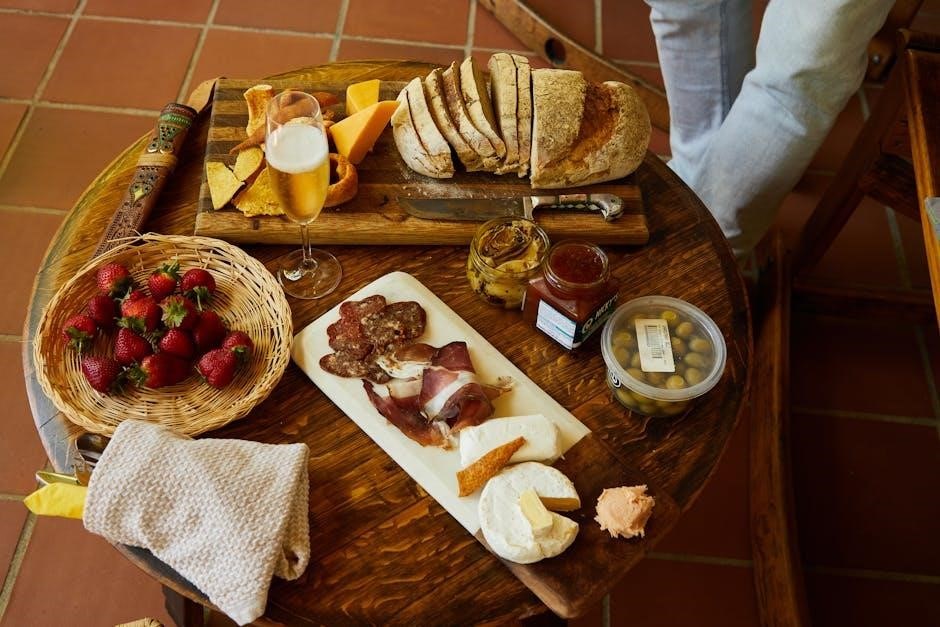
Essential Tools for Meat Slicing
The right tools are vital for precise meat slicing. Sharp knives, slicing machines, and cutting boards are indispensable, ensuring efficiency and safety in the process.
2.1 Best Knives for Slicing Meat
The best knives for slicing meat include a sharp chef’s knife, a carving knife, or a slicing knife. A chef’s knife is versatile for general slicing, while a carving knife excels at thin, even cuts for roasted meats. A cleaver is ideal for portioning larger cuts, and a utility knife handles smaller tasks. Sharpness is crucial for clean cuts, so regular sharpening is essential. Choosing the right knife ensures precision and efficiency in meat preparation.
2.2 Slicing Machines and Their Uses
Slicing machines are versatile tools designed to streamline meat preparation, offering precision and consistency. Available in manual, electric, and commercial models, they cater to various needs. These machines are ideal for uniform cuts, from thin deli slices to thicker portions. They save time and effort, especially for large quantities, ensuring even results. Whether for home use or professional kitchens, slicing machines enhance efficiency and deliver high-quality cuts across meats like beef, poultry, and pork.
Basic Meat Slicing Techniques
Freezing meat firms it for easier slicing, while cutting against the grain ensures tenderness. Even portioning guarantees uniform cooking and a professional finish to every dish.
3.1 Freezing Meat for Easier Slicing
Freezing meat briefly makes it firmer, reducing tear and improving precision. Place meat in the freezer for 30 minutes to an hour before slicing. This technique works especially well for delicate cuts like raw beef or poultry, ensuring thin, even slices. Use a sharp knife and slice against the grain for tender results. This method is ideal for dishes like stir-fries or sashimi, where uniformity and texture are key. Proper freezing enhances both ease and quality of slicing.
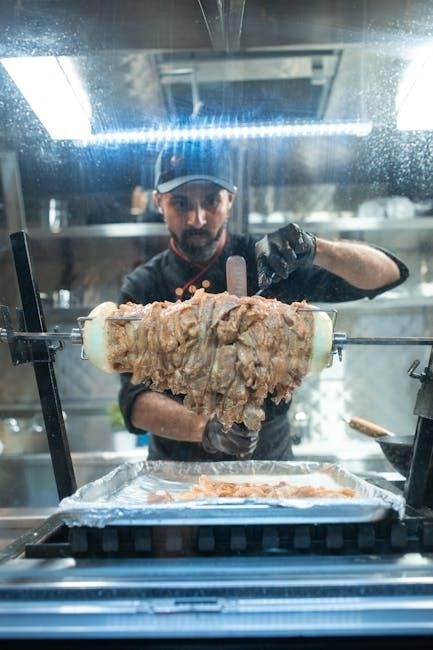
3.2 Slicing Against the Grain
Slicing against the grain ensures tender and flavorful meat by cutting perpendicular to the muscle fibers. Identify the grain by observing the lines on the meat’s surface. Lay the meat flat, hold your knife at a slight angle, and slice in a smooth, rocking motion from heel to tip. This technique reduces chewiness and enhances the overall dining experience. Always use a sharp knife for clean cuts and even portions.
3.3 Portioning and Cutting Evenly
Even portioning ensures consistent cooking and presentation. To achieve uniform slices, freeze meat slightly to firm it up, then slice using a sharp knife. Always cut against the grain for tenderness. For precise control, use a meat slicer or guide to maintain equal thickness. This technique is especially crucial for dishes like stir-fries or sandwiches, where uniformity enhances both flavor and visual appeal. Practice makes perfect in mastering even, professional-looking cuts every time.

Advanced Slicing Techniques
Advanced slicing involves precision methods like julienne cuts, sashimi-grade slicing, and expert portioning. These techniques require sharp tools and practice to achieve uniform, visually appealing results.
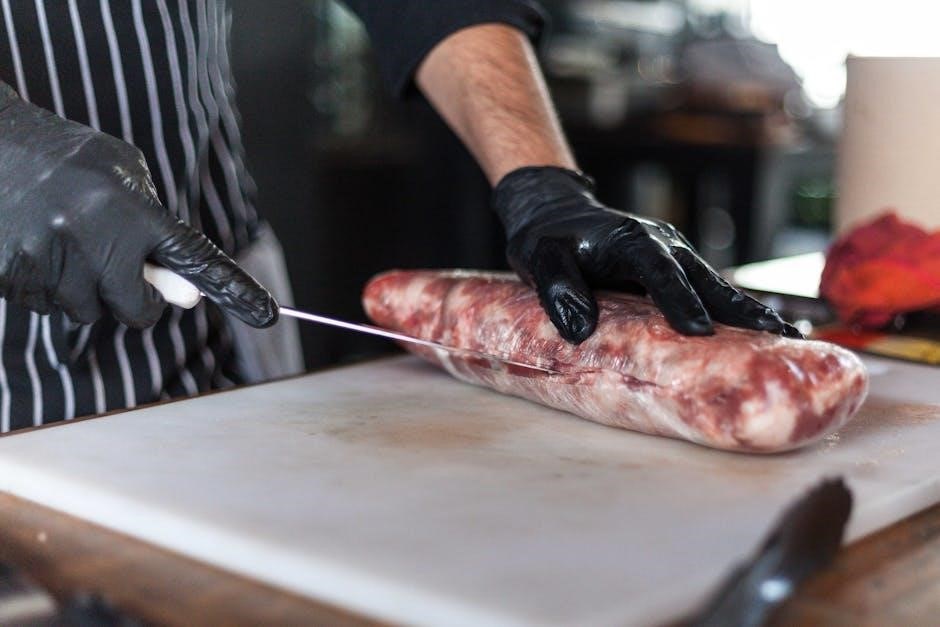
4.1 Julienne and Thin Strips

Julienne cuts involve slicing meat into long, thin strips, typically 1/8 inch thick; This technique is ideal for dishes like stir-fries or sukiyaki, where quick cooking is essential. To achieve thin strips, use a sharp knife and slightly freeze the meat for firmness. Slice against the grain for tenderness. Uniform strips ensure even cooking, while varied lengths add visual appeal. Practice this method to master both julienne and thin strip slicing for versatile meal preparation;
4.2 Sashimi-Grade Slicing
Sashimi-grade slicing demands precision and skill to achieve ultra-thin, even cuts. Often used for raw dishes, it requires a sharp knife and a steady hand. Freezing the meat slightly firms it up, making it easier to slice uniformly. Slicing against the grain ensures tenderness and a clean texture. This technique is essential for dishes like sushi or carpaccio, where presentation and flavor depend on perfection. Proper handling and tools are key to mastering this delicate art.
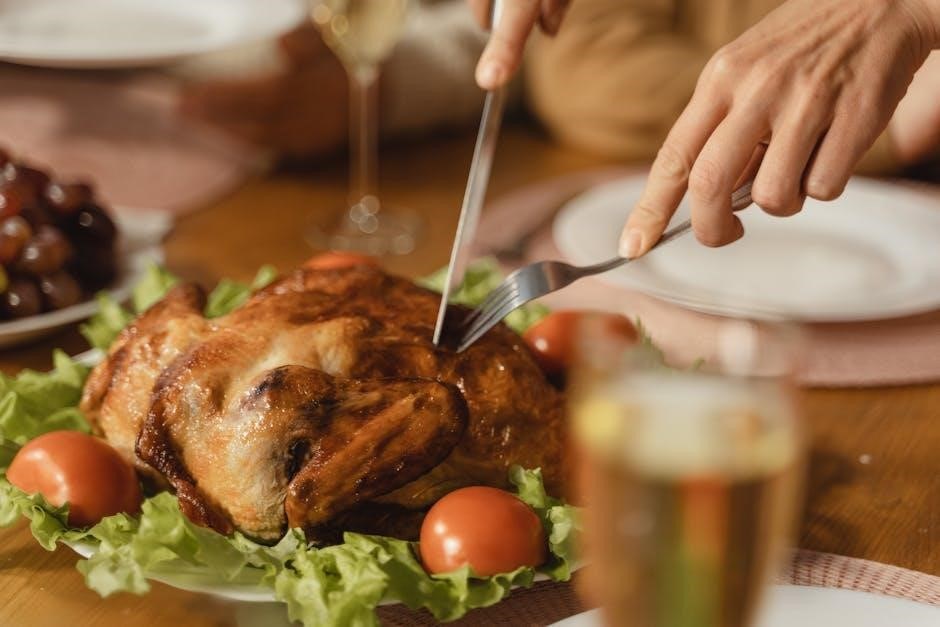
Safety and Best Practices
Safety is paramount when slicing meat. Always handle sharp tools with care, store sliced meat promptly, and maintain hygiene to prevent contamination and foodborne illness.
5.1 Handling Sharp Tools Safely
Handling sharp tools safely is crucial to prevent accidents. Always store knives in a secure place, out of reach of children. Use cut-resistant gloves and maintain a firm grip on the handle. Keep fingers curled under the knife and never touch the blade edge. Regularly sharpen knives to avoid applying excessive force. Clean tools immediately after use and store them properly. Never cut towards your body, and always maintain focus while slicing. Proper tool maintenance ensures longevity and safety.
5.2 Proper Meat Storage After Slicing
After slicing, store meat in airtight containers to prevent contamination and maintain freshness. Label containers with dates for easy tracking. Keep refrigerated at temperatures below 40°F (4°C) to inhibit bacterial growth. For longer storage, freezing is ideal; however, it may slightly affect texture. Ensure even freezing by portioning slices beforehand. Always thaw frozen meat safely in the refrigerator or under cold running water to preserve quality and safety.
Presentation and Plating
Presentation enhances the dining experience, with sliced meats arranged to highlight color, texture, and portion size. Creative plating and food styling elevate dishes to artistic culinary expressions.
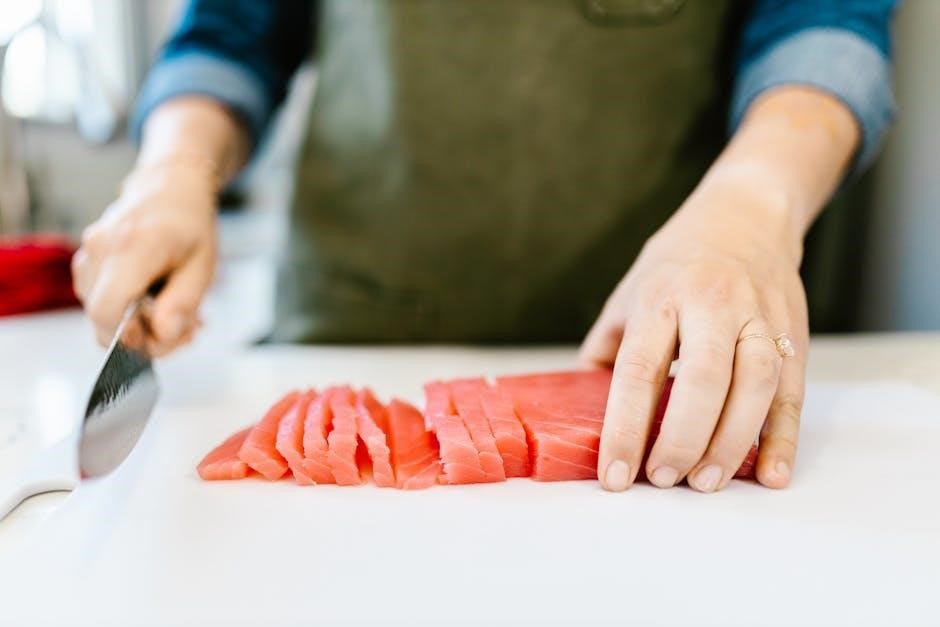
6.1 Visual Appeal of Sliced Meats
Visually appealing sliced meats elevate any dish, making it more enticing. Even, uniform cuts create a professional presentation, while vibrant colors and artistic arrangements enhance the plate’s attractiveness. Garnishes like fresh herbs or edible flowers add elegance. Proper slicing techniques ensure consistency, making the meat look as delicious as it tastes. A well-presented dish can transform a simple meal into a gourmet experience, showcasing both skill and creativity in the kitchen.
6.2 Food Styling Tips
For a visually appealing presentation, arrange sliced meats in a pattern that highlights their texture and color. Use garnishes like fresh herbs or edible flowers to add vibrancy. Ensure portions are evenly sized and neatly stacked. Contrast colors by pairing meats with fresh vegetables or sauces. Consider the plate’s balance—leave space for other elements to avoid clutter. Elegant plating enhances the dining experience, making each dish Instagram-worthy and appetizing.
Mastery of meat slicing techniques enhances culinary skills, ensuring tender, flavorful, and visually appealing dishes. Practice, precision, and proper tools guarantee consistent, professional results every time.
7.1 Summary of Key Slicing Techniques
Mastering meat slicing involves essential techniques like freezing for firmness, slicing against the grain for tenderness, and using sharp tools for precision. Proper portioning ensures even cooking, while advanced methods like julienne and sashimi-grade slicing enhance presentation. Consistent, even cuts are vital for both culinary appeal and flavor distribution. These techniques, when practiced, elevate dishes from ordinary to extraordinary, making meat slicing a skill worth perfecting for any culinary enthusiast or professional chef.
7.2 Final Tips for Mastering Meat Slicing
Mastering meat slicing requires patience and practice. Always slice against the grain for tender results and use sharp tools to maintain precision. Freezing meat slightly before slicing ensures even, thin cuts. Experiment with techniques like julienne or sashimi for advanced presentation. Store sliced meats properly to maintain freshness and safety. Consistent practice will elevate your skills, making every dish visually appealing and flavorful. Remember, the right tools and techniques are key to achieving perfection.
